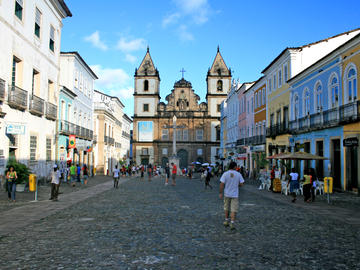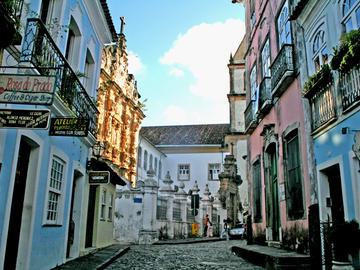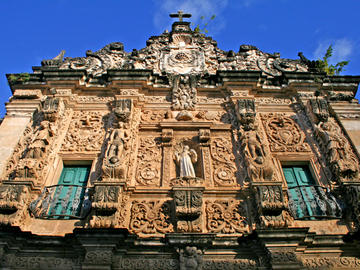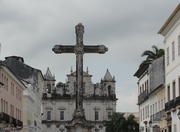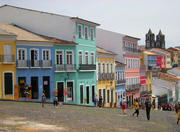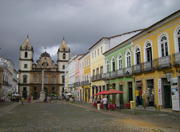Picture
More information on Largo do Pelourinho in Salvador Bahia

Description: Largo do Pelourinho in Salvador Bahia
Largo do Pelourinho is a historical part of Salvador and considered a city within a city. Lots of historic buildings within this area.
It is one of the main symbols of Salvador. During slavery times, was the place where slaves were punished. The square is surrounded by several old houses in the purest colonial style, including the house of Jorge Amado Foundation and churches like the Church of the Rosary of Black Men and Cathedral Basilica, two great examples of architecture from colonial times. Pelourinho is a chapter in the visit to Salvador, before the point of prostitution, drug dealing and violence, the site currently meets restaurants with the best flavor of Bahian cuisine, crafts, baroque architecture, religion, cultural centers and the legitimate drumming of Olodum . As the first capital of Portuguese America, or Salvadeo MAOD cultivated slave labor and had her fixed pillories several columns in public areas to expose and punish criminals. Originally installed at points as Terreiro of Jesus and the current squares Tomé de Souza and Castro Alves as a symbol of authority and justice, just lending his name to the set of architectural and historical Pelourinho - Historic Center part of the city. The construction of churches, mansions and townhouses on the site has intensified in the seventeenth century, during which the large landowners demonstrating their power in the architecture of aristocratic houses. The buildings of religious orders and the third and sumptuous houses that now surround the Terreiro de Jesus in the eighteenth century reflected the social stratification of the city. In the nineteenth century, trade gradually took the old residences of Taboão and spread to the Historic Center. Several professionals have to work and reside in the area and the aristocrats then moved to other parts of the city, contributing to the establishment of brothels in the homes of many rooms that have deteriorated over time. Pelourinho is also a source of inspiration and a stage for Brazilian and foreign artists - like Caetano Veloso and Paul Simon and even Michael Jackson has recorded scenes of a clip there. The historic center of Salvador also brings together some of the best restaurants and most bars in town. The cultural effervescence takes over the new, multicolored Pelourinho, the project mainly through Pelourinho Day & Night, held in various squares and streets of the neighborhood. The program leads to the public daily, with free admission, dances and music and theater performances for all tastes. The drumming can sometimes be replaced by reggae, the rhythm that has dominated the preference of nine out of ten in Bahia, but worth looking for. Tuesdays are reserved for concerts and blessing (Mass) that attracts many religious and then joins the profane as the test of Olodum and others shows, attracting thousands of people in the streets and squares of Pelourinho. But that is in Pelourinho Salvador meets your greatest asset, as revealed in the architectural details, in churches and colorful houses, engaged and live tour. Located in the historic center of Salvador and World Heritage listed by UNESCO (the United Nations for the Education, Science and Culture), Pelourinho is currently considered a large outdoor shopping mall attractions to offer artistic, musical and options bars, restaurants, clothing stores, jewelry and crafts, museums, theaters and churches, among others. The XV de Novembro Square, better known as Je sus Terreiro because of the Jesuit church (now Cathedral Basilica), has urban characteristics of past centuries. Three richly decorated mansions and churches bear witness to the heyday when Salvador was the capital of the colony. In the center of the square, a fountain of French origin (1855), all in cast iron, represents the goddess Ceres, agriculture. After years of neglect and deterioration, the historic center of Salvador - listed as a World Heritage Site and UNESCO - rose with all its architectural beauty. About 800 were recovered colonial mansions, serving as a starting point for economic revitalization, social and cultural area. His recovery has not been completed because it is being done in stages. The buildings of the 17th and 18th centuries were divided into groups. Most of the property is restored in Pelourinho, Terreiro de Jesus, Cathedral Square and the slopes of Mount Caramel. Salvador was born in Pelourinho When he first arrived here, Tomé de Souza tried to do the bidding of the king, founding the city named after Jesus Christ - the Savior, in the best point for the construction of "fortress city", now called the Pelourinho, the ideal place for its pretensions. The reasons for the choice of Pelourinho are quite clear. It is the highest part of town, across the harbor, near shopping and naturally fortified by the great depression exists which forms a wall of nearly ninety feet high, fifteen miles long, which would facilitate the defense of any threat from the sea. In a few years, Tomé de Souza constructed a series of large houses and mansions at the top of the wall, all based, of course, in the Portuguese baroque architecture and built with slave labor, black and indigenous. To give greater protection to the city, the Governor General has limited access only four gates, they totally destroyed during the unsuccessful attempts of domination of the city in the century. XVII. http://www.visiteabahia.com.br/visite/salvador/pelourinho/index.phpPhoto by: LetoCarvalhoMore Photos of Picture
